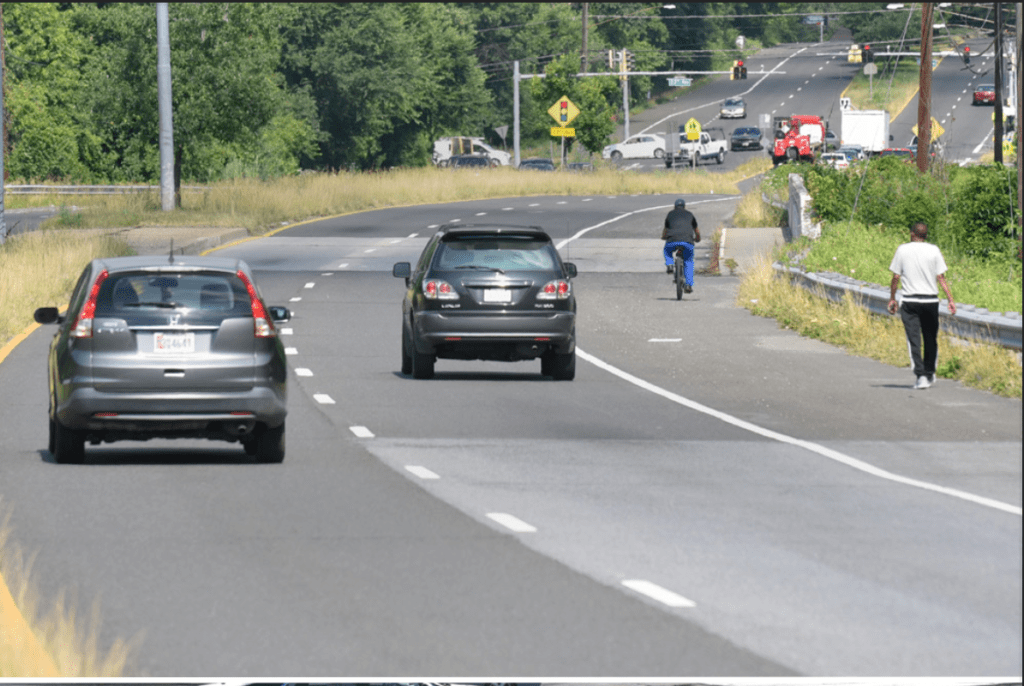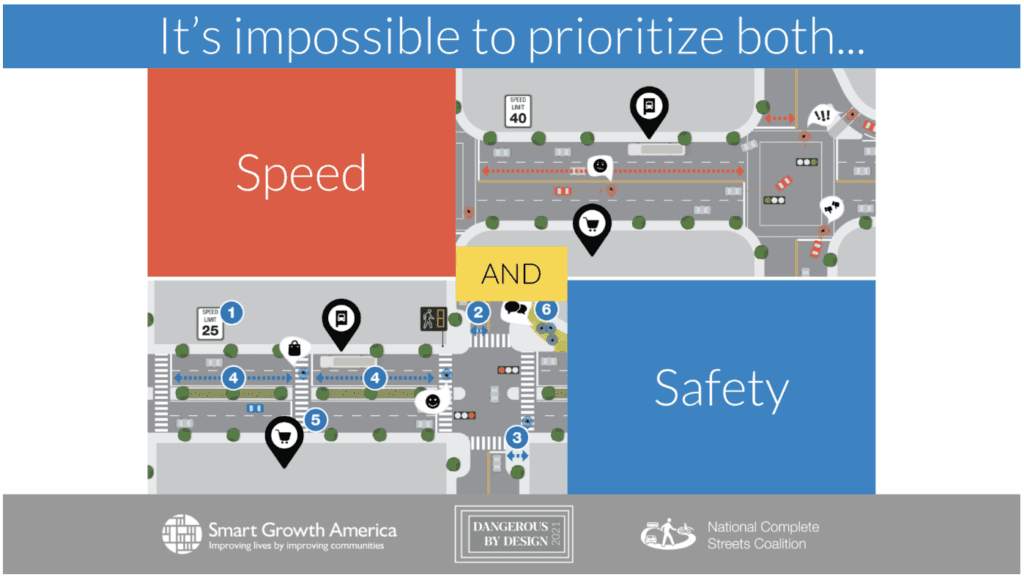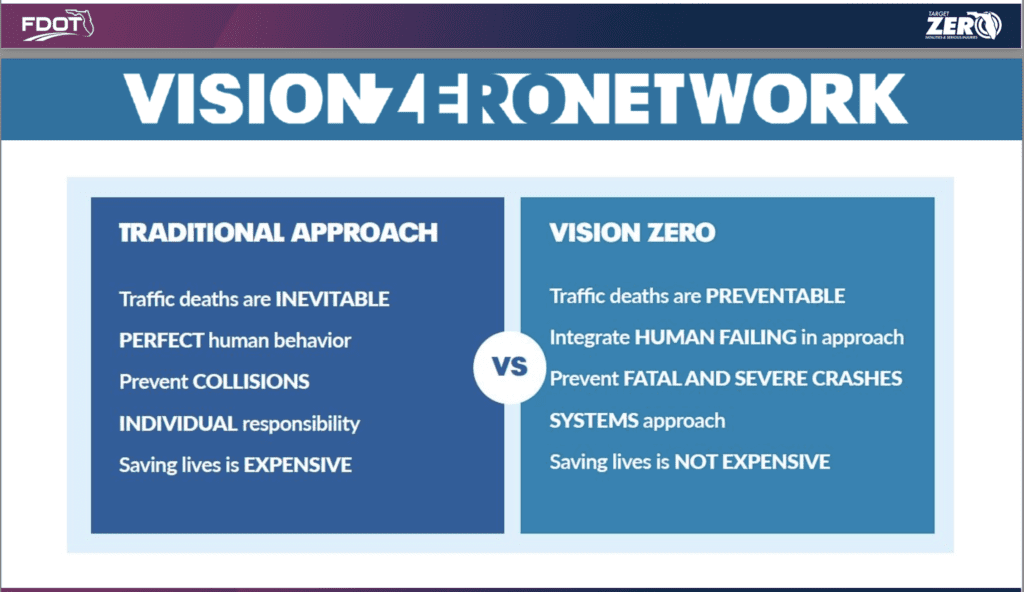
Dangerous by Design
By Ian Thomas
Annual pedestrian fatalities in the U.S. have been rising steadily for more than a decade. In that time, about 71,000 (disproportionately poor, Black, and brown) people have been killed while walking. And, surprisingly, with fewer cars on the road during the pandemic years of 2020 and 2021, the death rate spiked even higher than usual.
Or maybe not so surprising! … As noted in Smart Growth America’s recently published “Dangerous by Design, 2022,” driving speeds on America’s less congested roads increased dramatically, leading to more collisions which were also more deadly. Total traffic fatalities per mile in the U.S. jumped 21% in 2020, contrary to what happened in almost every other country in the world, where less driving led to fewer deaths.
The clear culprit is the design of our arterial roadways. These wide, straight, multi-lane corridors encourage excessive speeds in a complex driving environment which includes numerous driveways, turning movements, bicyclists, and pedestrians. A significant majority of pedestrian fatalities occur on arterials even though they make up a small fraction of the transportation network.
America Walks’ September 22 webinar brought together a panel of transportation professionals from the public and private sector, as well as the world of advocacy, to discuss what’s wrong with arterials, and how to fix them.
The Deadly Trade-off between Safety and Speed
When asked whether it’s possible to engineer roads for both safety and speed, Beth Osborne (Vice President of Transportation and Thriving Communities for Smart Growth America and lead author of “Dangerous by Design”) gave a nuanced response.

Interstate highways passing through natural or agricultural land with barriers separating opposing travel lanes and limited-access entry and exit ramps are designed to support high speeds with a very low crash rate. In contrast, arterials incorporate the same wide lanes, dead straight corridors, and long sight lines into a complex urban or suburban setting, where drivers must react to rapidly changing situations and too much information for the prevailing speeds. Margins of error are reduced, and small mistakes become deadly.
Beth described this situation as hostile to drivers. They are encouraged by roadway design to drive at high speeds and then punished by law enforcement with a speeding ticket … or much worse! Except in the highly controlled environment of Interstate highways, it is not possible to engineer roads for both safety and speed.
How Did the Planners and Engineers get it so Wrong?
According to “Dangerous by Design,” seven of the ten most deadly metro areas are in just two states –California and Florida.
Therefore, joining Beth Osborne on the panel were Toks Omishakin (Director of the California Department of Transportation) and Billy Hattaway (former Director of Transportation for City of Orlando, Florida, now with Fehr and Peers). Both of these professionals have dedicated their careers to improving transportation safety by changing the system from the inside.
When asked how the industry got it so wrong, Toks remarked that, for 60-70 years, the automobile “took over” transportation planning and design in the U.S. (it should be noted that most Americans supported this policy at the time). Massive federal subsidies for high-speed roadways were provided as cities sprawled and created ever-more distant suburbs, especially in the Sun Belt States where population growth was rapid.
According to Billy, federal transportation funding focused on responding to travel demand and moving vehicles quickly, so 4-lane and 6-lane arterials started radiating out from city centers while others encircled them. Because of political resistance from white, wealthy, and well-connected residents, the paths of destruction mostly went through poor, Black, and brown neighborhoods.
As a result, low-income families who cannot afford a car are disproportionately exposed to traffic violence as they attempt to walk and bike to work, school, and other destinations.
Traffic Calming for Arterials and Freeways
The combination of a high-speed freeway with lots of conflict points is “a recipe for deadly mistakes,” according to Beth Osborne.
Rather than rely on the “individual responsibility” of road users to prevent crashes, a Safe System approach must be employed with multiple layers of protection and an overarching focus on reducing vehicle speeds.

Billy Hattaway and Toks Omishakin described several specific design interventions, which they have implemented successfully in Florida and California:
- With closely spaced intersections, signal timings can be adjusted to manage the flow of traffic
- Modern roundabouts with vertical landscaping elements reduce vehicle speeds to 15-20 mph at conflict points
- Road diets can be designed to narrow travel lanes and/or reduce the number of lanes, with the additional space being designated for parking, protected bike lanes, and landscaping
- Pedestrian hybrid beacons (also known as HAWK Signals) should be installed in locations where residents need to cross an arterial on foot
- Raised crosswalks with bulb-outs and refuge islands slow down traffic speeds such that drivers will yield to waiting pedestrians
- High-quality lighting at all crossings is critical
Tips for Advocates
At the end of the webinar, Toks, Billy, and Beth gave the following advice for local advocates who want to be part of the solution to the problem of pedestrian fatalities on arterial roadways:
- Show up at City Council meetings
- Call for the Traffic Department to prioritize safety over speed: The State can use aggressive interventions if the community is in support
- Push for policy such as adopting a Safe System approach, identifying the “high-injury network,” and developing a Vision Zero Plan
- Support funding applications and recruitment of good technical staff
- Oppose all proposals for expanding the capacity of roadways
- Be resilient and keep trying in the face of resistance